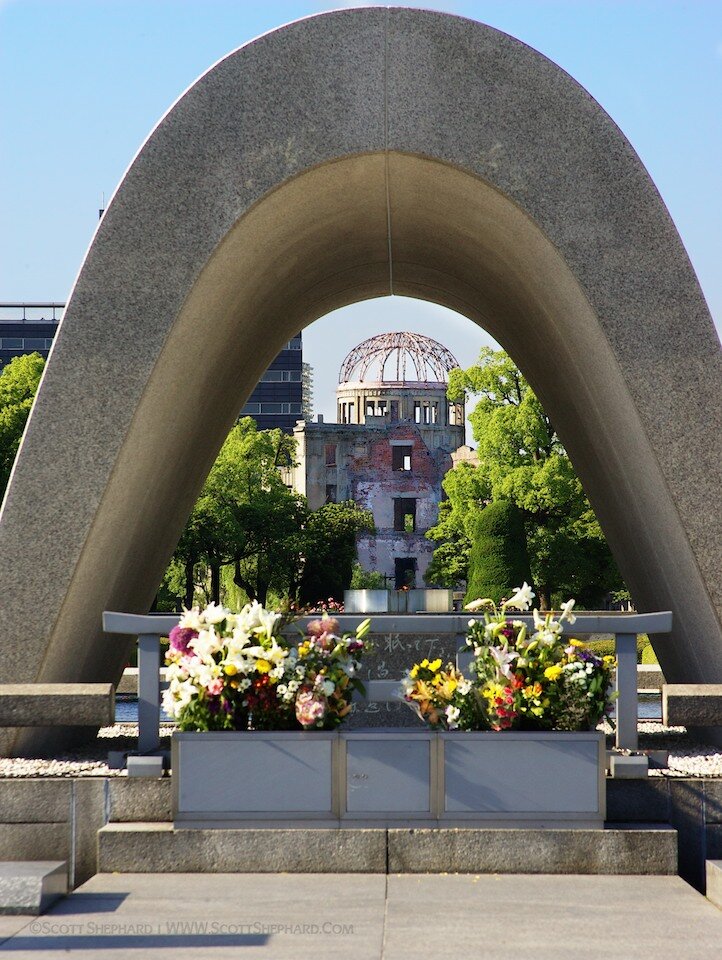 As I was thinking about the anniversary of the attack on the Twin Towers in New York on this day 11 years ago, I also thought about Hiroshima, which I visited in 2004.I avoid political commentary in this blog. So you should read nothing more into my post today beyond the fact that there have been many events in human history that have had profound impact on the architecture and psyche of a city but which also changed how everyone views the world. And I would say that 9/11 and the bombing of Hiroshima on August 6, 1945, are two such events.This photo, incidentally, shows the modern, arched Hiroshima Memorial (which shelters an eternal flame), framing a building which stood near ground zero. This building was left standing as the only remnant of a city center that was largely destroyed in the blink of an eye.
As I was thinking about the anniversary of the attack on the Twin Towers in New York on this day 11 years ago, I also thought about Hiroshima, which I visited in 2004.I avoid political commentary in this blog. So you should read nothing more into my post today beyond the fact that there have been many events in human history that have had profound impact on the architecture and psyche of a city but which also changed how everyone views the world. And I would say that 9/11 and the bombing of Hiroshima on August 6, 1945, are two such events.This photo, incidentally, shows the modern, arched Hiroshima Memorial (which shelters an eternal flame), framing a building which stood near ground zero. This building was left standing as the only remnant of a city center that was largely destroyed in the blink of an eye.
war
09-07-12 Contradiction
 Rick Steves, the American travel writer, says that for some Americans, a visit to Mostar is Bosnia can be "a bit jarring." This photo may be a good example of what he means: an inviting sidewalk cafe is juxtaposed next to a building that is riddled with bullet holes.I have been to Mostar twice and both times I am reminded of the long term consequences and scarring that war brings to people and cities. But Mostar also reminds me of the resilience of human beings. If you have a chance, I think you should spend some time in Mostar.
Rick Steves, the American travel writer, says that for some Americans, a visit to Mostar is Bosnia can be "a bit jarring." This photo may be a good example of what he means: an inviting sidewalk cafe is juxtaposed next to a building that is riddled with bullet holes.I have been to Mostar twice and both times I am reminded of the long term consequences and scarring that war brings to people and cities. But Mostar also reminds me of the resilience of human beings. If you have a chance, I think you should spend some time in Mostar.
09-06-12 The Old Bridge, Mostar
 Stari Most ("the Old Bridge) is a name I've seen for bridges in other places in for former Yugoslav Republic. But this particular bridge is the most famous Stari Most. It spans the Neretva River in Mostar, Bosnia. Though it is called "the Old Bridge," parts of it date back to very recent history because it has been reconstructed.It stood for close to 500 years before it was intentionally destroyed in the Croat-Bosniak war. In war there is a general convention that art and architecture are spared. But in this case the enemy made an exception. Fortunately, it has been meticulously reconstructed.
Stari Most ("the Old Bridge) is a name I've seen for bridges in other places in for former Yugoslav Republic. But this particular bridge is the most famous Stari Most. It spans the Neretva River in Mostar, Bosnia. Though it is called "the Old Bridge," parts of it date back to very recent history because it has been reconstructed.It stood for close to 500 years before it was intentionally destroyed in the Croat-Bosniak war. In war there is a general convention that art and architecture are spared. But in this case the enemy made an exception. Fortunately, it has been meticulously reconstructed.
06-08-09 Future Museum of the Homland War
 Driving south from Zagreb, you start to see the impact of the 1991 war over what used to be known as Yugoslavia. Near Slunj, Croatia, we encountered this place, which was a collection of weapons, generally of Soviet make, that were used and/or captured during this war. Nearby was a memorial for the local people who had died in the war.
Driving south from Zagreb, you start to see the impact of the 1991 war over what used to be known as Yugoslavia. Near Slunj, Croatia, we encountered this place, which was a collection of weapons, generally of Soviet make, that were used and/or captured during this war. Nearby was a memorial for the local people who had died in the war.
In this photo a young child is encouraged to climb up on one of the tanks. In the background is a shelled out building that was clearly involved in a ground battle. Look closely and you can see dimpled holes in the building. Those are from bullet strikes.
